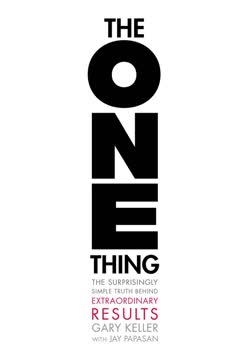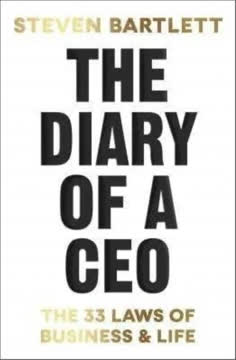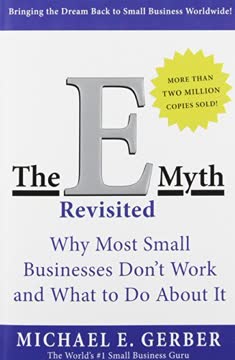Key Takeaways
1. Build a Business, Not a Job: Escape the Self-Employment Trap
You don't need to be in control; you need your business to be in control.
The Self-Employment Trap is a common pitfall for business owners who build their companies around their personal production. This approach leads to long hours, high stress, and limited growth potential. To escape this trap:
- Focus on creating systems and processes that can operate without your constant presence
- Develop a team that can handle day-to-day operations
- Shift your role from primary producer to strategic leader
Building an owner-independent business allows you to:
- Increase your company's value
- Achieve greater financial security
- Enjoy more personal freedom
- Scale your business more effectively
2. The Level Three Map: A Journey to Owner Independence
It's a progression, not an on/off switch.
The Level Three Map outlines the stages of business growth from start-up to owner independence:
- Level One: Planning and proving viability
- Level Two Early Stage: Securing clients and becoming profitable
- Level Two Middle Stage: Establishing business core and systems
- Level Two Advanced Stage: Refining systems and building management team
- Level Three: Achieving owner independence
Key milestones for reaching Level Three:
- Developing solid leaders in four of five core business areas
- Implementing clear processes for all business functions
- Creating an enterprise-level dashboard for monitoring business health
- Establishing traditions and culture to maintain vision and values
3. Master the Five Functional Pillars of Every Business
No company will thrive without having a well-organized, strong Operations Pillar.
The five functional pillars that support every successful business are:
- Sales and Marketing: Generating leads and closing sales
- Operations: Fulfilling promises and managing back-office functions
- Team: Hiring, training, and managing staff
- Finance: Managing cash flow, accounting, and financial reporting
- Executive Leadership: Setting vision, strategy, and guiding the company
For each pillar, focus on:
- Developing systems and processes
- Identifying key performance indicators (KPIs)
- Creating accountability structures
- Continuously improving and refining operations
4. Systematize Your Business for Scalability and Success
Systems are reliable processes and procedures that empower your business to consistently produce an excellent result for your clients or customers.
Creating a systems-driven business is crucial for achieving owner independence and scalability. Key steps include:
-
Develop your Ultimate Business System (UBS):
- Create a file folder organizational hierarchy
- Break down business areas into subareas
- Populate with existing systems and identify gaps
- Build new systems progressively
-
Focus on four core business systems:
- Lead generation
- Lead conversion
- Production and delivery
- Collections
-
Continuously refine and improve systems:
- Involve your team in system creation and improvement
- Use feedback and data to optimize processes
- Regularly review and update systems
5. Develop a Strong Team and Leadership Structure
The most successful companies get all their moving parts working in alignment with each other to achieve their top objectives in a manner consistent with their core values and priorities.
Building a capable team and leadership structure is essential for creating an owner-independent business:
- Hire and develop key leaders for each business pillar
- Create clear roles, responsibilities, and accountability structures
- Implement effective hiring, training, and evaluation processes
- Foster a culture of ownership and initiative among team members
Leadership responsibilities:
- Setting big-picture vision and strategy
- Growing and grooming the leadership team
- Anticipating future challenges and opportunities
- Establishing and reinforcing company culture and values
6. Maximize Time Efficiency with Strategic Time Mastery
Trading time for dollars is a Level Two reaction. Upgrading your use of time to create more with less is the Level Three solution.
Implement time mastery strategies to reclaim valuable time for high-impact activities:
- Identify A, B, C, and D level activities based on value creation
- Focus on eliminating or delegating D level activities
- Structure your week with Focus Days and Push Days
- Use the "Four Ds" to manage tasks: Delete, Delegate, Defer, Design out
- Schedule Prime Time blocks for high-value work
- Create a "Stop Doing" list to eliminate low-value activities
Key time mastery techniques:
- Set aside one Focus Day per week for high-leverage activities
- Use Push Days to move projects forward and handle day-to-day tasks
- Implement the Results Rule: Complete or schedule your three "big rocks" by 10:30 AM
- Leverage accountability and environment design to maintain discipline
7. Overcome Limiting Excuses and Take Action for Growth
In life, if you argue for your excuses you get to keep them.
Identify and overcome common excuses that hold business owners back from achieving their goals:
- "I can't afford it": Consider the true cost of the status quo and potential ROI of investments
- "I don't have the time": Start small, with just a few hours per week dedicated to high-value activities
- "I'm overwhelmed": Break down tasks into manageable steps and seek support or guidance
- "Now's just not the right time": Recognize that there's never a perfect time and start making progress now
Strategies for taking action:
- Set clear, specific goals for your business
- Create an accountability structure (e.g., business coach, peer group)
- Break down larger objectives into smaller, achievable steps
- Celebrate progress and learn from setbacks
- Continuously educate yourself and seek guidance from mentors or advisors
Last updated:
FAQ
What's "Build a Business, Not a Job" about?
- Core Concept: The book by David Finkel focuses on transforming a business from being owner-reliant to owner-independent, allowing the business to thrive without the owner's constant presence.
- Three Levels: It introduces the concept of three levels of business growth, with Level Three being the ultimate goal where the business operates independently of the owner.
- Practical Guidance: The book provides a detailed map and strategies for business owners to scale their businesses while reclaiming their personal time and freedom.
- Real-Life Examples: It includes stories and case studies of business owners who successfully transitioned their businesses to become owner-independent.
Why should I read "Build a Business, Not a Job"?
- Achieve Freedom: If you're a business owner feeling trapped by your business, this book offers a pathway to regain your time and freedom.
- Proven Strategies: The book provides actionable strategies and a clear roadmap to scale your business effectively.
- Avoid Common Pitfalls: It highlights common mistakes business owners make and how to avoid them, saving you time and resources.
- Inspiration and Motivation: Through real-life success stories, the book inspires and motivates you to take the necessary steps toward building a sustainable business.
What are the key takeaways of "Build a Business, Not a Job"?
- Owner-Independent Business: The ultimate goal is to create a business that can operate without the owner's daily involvement.
- Three-Level Model: Understand the progression from a start-up to a sustainable, scalable, and eventually owner-independent business.
- Time Mastery: Learn strategies to reclaim your time and focus on high-value activities that drive business growth.
- Building Blocks: The book outlines eight essential building blocks for creating an owner-independent business, including systems, team, and culture.
How does the "Level Three Map" work in "Build a Business, Not a Job"?
- Detailed Stages: The Level Three Map breaks down the business growth process into distinct stages, from start-up to owner-independent.
- Focus Areas: Each stage has specific focus areas and leverage points to guide business owners in their journey.
- Progression: It emphasizes that building an owner-independent business is a progression, not an on/off switch.
- Strategic Planning: The map includes strategic planning and execution steps to ensure consistent progress toward Level Three.
What are the "8 Building Blocks" mentioned in "Build a Business, Not a Job"?
- Systems: Reliable processes and procedures that empower your business to consistently produce excellent results.
- Team: Leveraging the unique talents of other people to build a strong, independent business.
- Controls: Intelligent checks and balances that put your business in control, not you.
- Scalable Solutions: Removing barriers and unnecessary constraints to allow for business growth.
What are the "5 Functional Pillars" of every business according to "Build a Business, Not a Job"?
- Sales and Marketing: Responsible for defining your market, finding prospective customers, and generating sales.
- Operations: Fulfills the promises made by sales and handles back-office functions.
- Human Resources (Team): Manages hiring, training, and reviewing staff, ensuring compliance with labor laws.
- Finance: Deals with accounting, cash flow management, and financial reporting.
- Leadership: Sets the big-picture vision and strategy for the business, guiding all other pillars.
How can I reclaim my time using strategies from "Build a Business, Not a Job"?
- Identify Value-Creating Activities: Focus on activities that truly create value for your business and eliminate or delegate others.
- Focus Days: Set aside one day each week to work on high-value activities without distractions.
- Prime Time Blocks: Schedule 60-minute blocks during your peak productivity times to focus on important tasks.
- Stop Doing List: Regularly update a list of activities you will stop doing to free up time for more valuable work.
What are the "4 Most Costly Excuses" that hold business owners back according to "Build a Business, Not a Job"?
- "I can't afford it": Many business owners focus on the cost of change rather than the cost of maintaining the status quo.
- "I don't have the time": The book emphasizes the importance of reclaiming time to focus on business growth.
- "I'm overwhelmed": Feeling overwhelmed is common, but the book provides strategies to regain control and clarity.
- "Now's just not the right time": Waiting for the perfect time is a costly mistake; the book encourages starting now.
What are some of the best quotes from "Build a Business, Not a Job" and what do they mean?
- "Do you own your business, or does your business own you?" This quote challenges business owners to evaluate their current situation and strive for a business that operates independently.
- "In life, either you get your excuses or you get your dreams, but you don’t get both." It emphasizes the importance of letting go of excuses to achieve your business and personal goals.
- "The greatest challenge you’ll ever face as an entrepreneur is how to build a business that’s independent of you, the business owner." This highlights the core challenge addressed in the book and the ultimate goal of achieving owner independence.
How does "Build a Business, Not a Job" suggest handling the "Self-Employment Trap"?
- Recognize the Trap: Understand that building a business around personal production leads to being trapped in the business.
- Shift Focus: Move from being a producer to a builder of a business that operates independently.
- Leverage Systems and Team: Develop systems and empower your team to take ownership of business functions.
- Progress Gradually: Accept that escaping the trap is a progression, not an immediate change.
What role does a business coach play according to "Build a Business, Not a Job"?
- Outside Perspective: A business coach provides an external viewpoint to help you see your business clearly and objectively.
- Accountability: Coaches hold you accountable for your actions and decisions, ensuring consistent progress.
- Experience and Guidance: They offer insights and strategies based on their experience to help you avoid costly mistakes.
- Structured Program: The book emphasizes choosing a coaching program that aligns with the goal of building an owner-independent business.
What is the "Ultimate Business System" (UBS) in "Build a Business, Not a Job"?
- Master System: The UBS is the master system for organizing, storing, and refining all your business systems.
- Living Practice: It encourages making systems a living, breathing part of your business culture.
- Organizational Hierarchy: The UBS involves creating a file folder structure to organize business functions and systems.
- Team Involvement: Engage your team in building and refining the UBS to ensure it captures best practices and key knowledge.
Review Summary
Build a Business, Not a Job received mixed reviews, with an overall rating of 3.97 out of 5. Some readers found it valuable for scaling businesses and appreciated its practical advice. However, others criticized it for containing repetitive information and excessive self-promotion. Positive reviews praised the book's insights on creating an owner-independent business, while negative reviews felt it lacked depth and originality. Some readers found the additional resources helpful, while others were unimpressed with the free materials offered.
Similar Books









Download PDF
Download EPUB
.epub digital book format is ideal for reading ebooks on phones, tablets, and e-readers.




